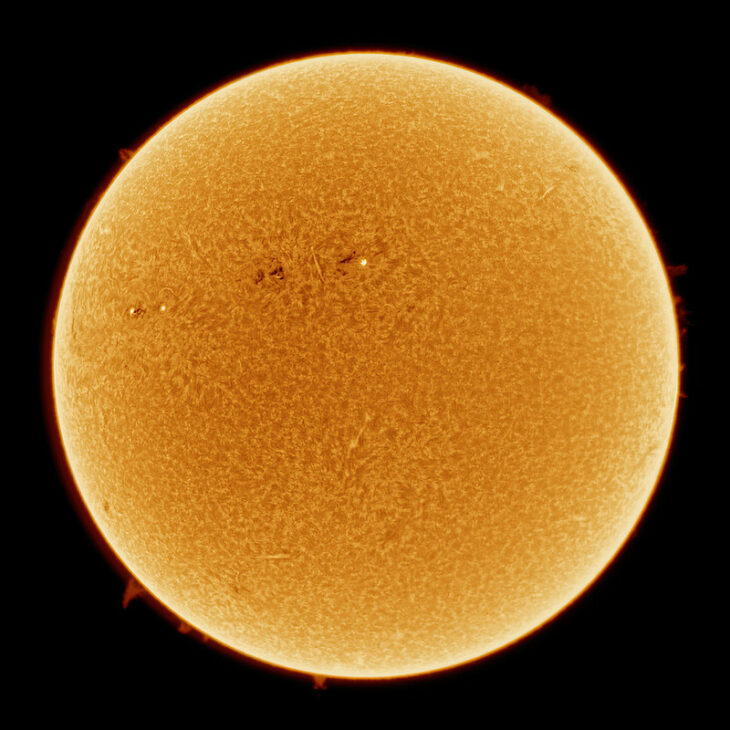The Sun is the source of heat and light for the entire solar system, which are produced within its core by hydrogen ions smashing into helium in a process known as nuclear fusion. So, even though the Sun’s surface is very hot by Earth standards, around 10,000°F or 5,600°C, it’s relatively cold compared to its center, which is around 27,000,000°F or 15,000,000°C.
Two major processes transport heat and light from the Sun’s center to its surface. One is the same way the Sun heats the Earth, through radiation. In this case, energy moves outward from the center through light particles or photons. The other way heat moves through the Sun happens all the time on Earth: hot gases rise while cold gases fall, a phenomenon known as convection. This movement creates swirling currents inside the Sun as hot gas near the core pushes up to the surface, while gas that cools after exposure to space falls back to the core.

A diagram of the Sun showing its layers. Convection and radiation dominate the movement of heat at different depths. “Sun poster” by Kelvinsong is licensed under CC BY-SA 3.0.
The combination of radiation, convection, and the fact that parts of the Sun rotate at different speeds depending on their distance from its equator means that the Sun’s surface is unevenly heated, creating relatively hot and cold spots. While scientists understand this general pattern, they’ve found discrepancies between models of the Sun’s surface temperatures and findings from real observations. Specifically, current models suggest the Sun should have bubbles of plasma as cold as 2,000 Kelvin (K), around 3,100°F or 1,700°C, or colder. Yet, the coldest bubbles scientists have found are still much hotter, at approximately 4,000K, around 6,700°F or 3,700°C.
This discrepancy indicates a problem with current models of how heat moves through the Sun. It suggests that some unknown factor or factors provide a missing 1,000K or more to the Sun’s coldest parts. A team of scientists tested one explanation for the missing heat by performing 2 and 3-dimensional simulations. They proposed that as convection pulls neutrally-charged gases away from the center of the Sun, the negatively-charged electrons within these gases get jostled by magnetic fields near the Sun’s surface, creating additional heat. This process is known as Thermal Farley–Buneman Instability or TFBI turbulence.
They used 2 computer programs, known as Ebysus and EPPIC, to simulate a cold bubble on an outer layer of the Sun known as the chromosphere over a period of 8 to 10 milliseconds. They included factors in the simulation like the density of matter, the strength of magnetic fields, and how frequently collisions happened. Then they compared the heating observed from adding TFBI turbulence to the Ebysus program in 2D and the EPPIC program in both 2D and 3D.
The primary difference between the programs they used is that Ebysus treats the gases in the Sun as a swirling fluid, which makes it easier for computers to calculate their motions. In contrast, EPPIC treats the gases in the Sun as a collection of bouncing particles that generate little electromagnetic fields, which makes it harder for computers to calculate the results. They ran 5 simulations: 1 in 2D in Ebysus, which would have been the fastest but potentially least accurate; 2 in 2D in EPPIC, which would have been slower but more accurate to real life; and 2 in 3D in EPPIC, which would take the longest time to compute but produce the most accurate results.
Their 2D results showed that turbulent heating could add 700K or more to the cold region. They found a similar increase in temperature in their 3D simulations. The team claimed that their simulations indicated TFBI turbulence can add heat to cold parts of the Sun past the ambient heat from convection and radiation. However, they suggested researchers study this process further and over longer timescales to understand its full impact. Additionally, comparisons between their 2D and 3D simulations suggested that scientists can use the relatively faster 2D fluid computer models to study this phenomenon and get similar results to more complex and expensive 3D particle models.


